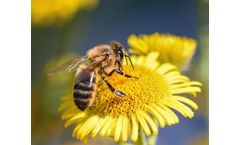Refine by
Honeybee Articles & Analysis
25 articles found
Chemical substances make insect pheromones what they are: compounds made from precursor molecules through chemical reactions. In most pheromones, there is more than one active component – that is, two or more constituents act by making a mixture. The nature and amount of insect pheromone elements are highly speciose, and even within close groups pheromone elements can be very different. ...
Royal Jelly is a honeybee product with unparalleled health benefits for humans, earning it the nickname “elixir of ...
The scientific name for pollen seed is ‘microgametophytes’ and these produce the male gametes which, via pollination, find their way to the female stigma of plants resulting in fertilisation, Figure 2. The nectar and pollen honeybees return to their hives with is turned into honey, which they store for winter months.The study of pollen is called palynology and its important for ...
As a companion to these plant beds, another addition to our rooftop has created quite the buzz–a colony of honeybees that will help pollinate our garden and the nearby greenery around the Eastlake neighborhood. ...
On July 12, 2019, the U.S. Environmental Protection Agency (EPA) announced in a Decision Memorandum that it has registered new uses and restored previously registered uses for sulfoxaflor. EPA has approved the use of sulfoxaflor on alfalfa, corn, cacao, grains (millet, oats), pineapple, sorghum, teff, teosinte, tree plantations, and restored the uses on citrus cotton, cucurbits (squash, ...
General Information Neonicotinoids are a family of active substances which include imidacloprid, acetamiprid, thiacloprid, dinotefuran, nitenpyram, thiamethoxam and clothianidin. They are used in plant protection to control harmful insects and also in veterinary medicine. The name literally means “new nicotine-like insecticide” due to the chemical similarity to nicotine. Sometimes ...
Staggering Growth of Almond Farms Honeybee researcher Kelly Watson and her team of geoscience graduate students were studying honeybee pollination in 2016 but changed the focus of their study to land use conversion after aerial photographs showed that there had been a dramatic uptick in the amount of natural land converted to almond orchards. ...
On August 29, 2016, the U.S. Geological Survey (USGS) published a study on the result of land-use changes on North and South Dakota commercial honey bee colonies in the journal Proceedings of the National Academy of Sciences. USGS scientists found that grasslands and other landscape features favored by beekeepers were decreasing, with crops that are avoided by beekeepers, such as corn and ...
Greenhouse Vegetables: Develop strategies for 12 month production. Honeybees and Pollination: Research the potential improvement of pollinator health through the implementation of an IPM program in crop production. ...
To feed the Asian honeybees throughout the growing season, Nashala village farmers have started to diversify their farms again. ...
ByEnsia
Not long ago, many claimed that significant honeybee decline was due to planting crops, especially corn, with neonicotinoid seed treatments such as imidacloprid. ...
Metal pollution has been increasing rapidly over the past century, and at the same time, the human population has continued to rise and produce contaminants that may negatively impact pollinators. Honey bees (Apis mellifera L.) forage over large areas and can collect contaminants from the environment. The primary objective was to determine whether the metal contaminants cadmium (Cd), copper ...
This study was designed to assess homing behaviour of bees foraging on winter oilseed rape grown from seed treated with thiamethoxam (as Cruiser OSR) with one field drilled with thiamethoxam treated seed and two control fields drilled with fungicide‐only treated seed. Twelve honeybee colonies were used per treatment group, 4 each located at the field edge (on‐field site), at ...
What we sometimes call the “agri-food system” is clearly broken — just ask farmworkers and food workers (exploited and underpaid), honeybees (collapsing), forested landscapes (fragmenting), the climate (warming), and the ever-growing number of people without access to nutritious food, or the land and resources with which to produce it. ...
ByEnsia
The honey bee, Apis mellifera L. is the most important managed pollinator species worldwide and plays a critical role in pollination of a diverse range of economically important crops. Due to this species' importance to agriculture and its historical use as a surrogate species for pollinators to evaluate the potential adverse effects for conventional, biological and microbial pesticides, as ...
In pesticide risk assessment, the estimation of the routes and levels of exposure is critical. For honey bees, the toxicity of pesticides is assessed by thorax contact to account for all possible contact exposures of bees subjected to a pesticide spray. In this study, we tested 6 different active substances with different hydrophobicity, and for the first time, we demonstrated that it is ...
Bees play a crucial role in pollination and generate honey and other hive products; therefore, their worldwide decline is cause for concern. New broad‐spectrum systemic insecticides like fipronil can harm bees, and their use has been discussed as a potential threat to bees' survival. In the present study, the authors evaluated the in vitro toxicity of fipronil and noted behavioral and motor ...
Alex Lu of Harvard University and others have linked them to colony collapse disorder, a phenomenon affecting farmed honeybees whose adults mysteriously die or vanish. As well, because the pesticide remains in pollen and nectar in small quantities, it can have chronic effects on pollinators such as bees. ...
ByEnsia
Honeybee waggle dancers are helping researchers identify conservation best practices. ...
ByEnsia
The European honeybee, Apis mellifera, is an important pollinator of agricultural crops. ...









